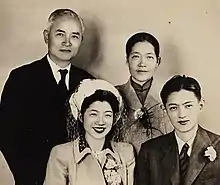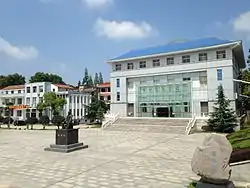Li Siguang
Li Siguang (Chinese: 李四光; pinyin: Lǐ Sìguāng; Wade–Giles: Li Ssu-kuang; 1889–1971), also known as J. S. Lee, was a Chinese geologist and politician. He was the founder of China's geomechanics. He was an ethnic Mongol.[1][2] He made outstanding contributions, which changed the situation of "oil deficiency" in the country, enabling the large-scale development of oil fields to raise the country to the ranks of the world's major oil producers.
Li Siguang | |
|---|---|
 | |
| Born | 26 October 1889 |
| Died | 29 April 1971 (aged 81) Beijing, China |
| Nationality | Chinese |
| Alma mater | Osaka Technical College University of Birmingham |
| Scientific career | |
| Institutions | Peking University |
Biography
Li was born as Li Zhongkui (李仲揆) in Huanggang, Hubei Province. His paternal grandfather was a Mongolian beggar who migrated to Hubei in search of a better livelihood, and his family originally had the Mongol surname "Kuli" (库里) or "Ku" (库).[3] He was often known in English as J. S. Lee (J for Zhongkui/Jung-kuei, S for Siguang).[4]
Li studied in Osaka Technical College in Japan and the University of Birmingham in UK in his early years. He became a geological professor at Peking University upon his return from abroad in 1920. Li Siguang was Wuhan University building preparatory chairman from July 1928 to April 1938. He was the president of National Central University (Nanjing University) in 1932.
After the People's Republic of China was established, Li held the positions of vice president of the Chinese Academy of Sciences (CAS) and minister of geology.
After the end of the Cultural Revolution (1966–1976), Xu Chi published Li's biography entitled The Light of Geology (地质之光), which was widely read and made Li a household name in China.[5]
Family

Li Siguang's daughter Li Lin was a physicist and academician of the CAS. She married Chen-Lu Tsou (Zou Chenglu), a distinguished biochemist and academician, while they were both attending the University of Cambridge in England. Li's family is thus the only one in China that has produced three academicians.[6] Li Lin's daughter, Zou Zongping (邹宗平) followed her grandfather's footsteps and became a geologist.[7]
References
- "民族博物馆_中国科普博览". Kepu.net.cn. Retrieved 30 November 2017.
- "李林档案资料_著名物理学家李林纪念馆". Eeloves.com. Retrieved 30 November 2017.
- Ba, Yi'er. "父女院士:李四光和李林的故事". Eastday. Retrieved 2018-06-29.
- Cao Lan 曹岚 (2018-04-11). "地质学家之外的李四光". CPPCC. Retrieved 2018-06-30.
- Zhang Shouren 张守仁 (December 2016). "揭开诗人徐迟跳楼之谜" (in Chinese). Chinese University of Hong Kong. Retrieved 2019-10-04.
- "邹承鲁:忆恩师·回国". People's Daily. 2006-11-24. Retrieved 2018-06-28.
- Jin, Yu (2007-04-09). "李四光·李林·邹承鲁共组"院士之家"". Tianxia Weekly. Retrieved 2018-06-28.
